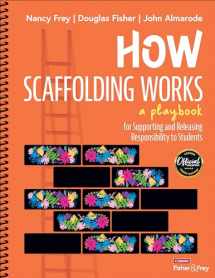
How Scaffolding Works: A Playbook for Supporting and Releasing Responsibility to Students
Book details
Summary
Description
Review
"Almarode, Fisher, and Frey have expertly created an insightful, timely, practical playbook for teachers and school leaders who want to learn more ways to ensure that all students gain skills using supportive structures called scaffolds. Most of all, educators will enjoy the techniques for using ongoing formative assessment and spiraling curriculum." -- Virginia E. Kelsen, PhD
"At a time when every educator and transformational leader are strategizing on how to eliminate inequities and achievement gaps among their scholars, this book is a valuable, timely resource. The authors have masterfully defined the characteristics of effective scaffolding to make instruction and learning both accessible and relevant for all learners, regardless of the level they begin. I view this ′playbook′ as an absolute necessity―for its clarity and focus on the steps educators can take to help all scholars reach their highest academic potential." -- Dana Trevethan
"How Scaffolding Works is a highly-engaging and thought-provoking resource for school administrators, instructional coaches, and teachers to collaboratively learn about scaffolding. Each module includes real-life examples, opportunities for peer discussion and an easy-to-use framework for deliberately planning scaffolds for ALL learners throughout the learning process. This playbook is a must read for anyone wanting to learn how to use high-effect size strategies to scaffold learning." -- Alisa Barret
"This text provides a fresh lens through which to view the practice of scaffolding, applicable to all grade bands and subject areas!" -- Tiffany Coleman
Provide the perfect structure and support to develop student independence.
Effective scaffolding leads to learner autonomy―but too many educators have been airlifting students to right answers, perpetuating a generation who don’t know how to learn. Yes, we know the sweet spot for learning involves giving our students the right blend of productive failure and productive success, but how to do it is cloaked in misconceptions.
How Scaffolding Works unveils the essential moves and methods. Ten interactive modules help every K-12 educator structure support in new ways, including knowing how to: Gradually release responsibility to students through intentional and purposeful scaffolding Design lessons and experiences that attend to the affective, metacognitive, and cognitive aspects of learning Collect data before, during, and after learning, so we can place, move, and take away scaffolds with greater intention Promote independence with front-end scaffolds, distributed scaffolds, back-end scaffolds, peer scaffolds, and fading scaffolds Use a blend of demonstration, modeling, coaching, explaining, questioning and choice Promote purposeful practice―in which learners knows where they’re going and how to get there
Perhaps we rush in to rescue learners because the world seems fraught; we want to help our students reach the safety of academic success. Our intentions are good, but it’s time to step back, gradually and purposefully, and let them pilot their own learning.


We would LOVE it if you could help us and other readers by reviewing the book
Book review



